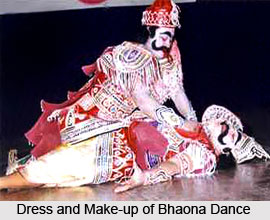 The dress and makeup during the Bhaona dance is usually very appealing. The dress of a Sutradhar who is the choreographer and director of the dance and the play is very significant. It consists of a `Ghuri` meaning Ghagra and a `Chaddar` meaning a piece of cloth crossed at his chest and hung up from both the shoulders and remains tied at the waist. The Sutradhar also wears a full-sleeved tight singlet (bundi) which remains tied at the sides by strings. He also puts on a silk turban which remains surrounded by a garland of Tulsi leaves. The colour of his dress is usually white. The Sutradhar along with all the performers wears a peculiar form of anklet termed as `Nupurs.` They are made up of thin iron or brass wires and are round in shape. Inside these wires there are round metal pieces.
The dress and makeup during the Bhaona dance is usually very appealing. The dress of a Sutradhar who is the choreographer and director of the dance and the play is very significant. It consists of a `Ghuri` meaning Ghagra and a `Chaddar` meaning a piece of cloth crossed at his chest and hung up from both the shoulders and remains tied at the waist. The Sutradhar also wears a full-sleeved tight singlet (bundi) which remains tied at the sides by strings. He also puts on a silk turban which remains surrounded by a garland of Tulsi leaves. The colour of his dress is usually white. The Sutradhar along with all the performers wears a peculiar form of anklet termed as `Nupurs.` They are made up of thin iron or brass wires and are round in shape. Inside these wires there are round metal pieces.
The Dhyamalis in the drama play the role of warning bells. Next Krishna, the most symbolic character appears on stage. The person portraying the role of Lord Krishna is coloured blue and wears a yellow coloured dhoti.
The colours applied on the performers are extracted from the barks, leaves and flowers of a particular type of tree. This paste is known as `Hengul Hightali.` It is from these parts of the tree that different shades of colour, like blue, yellow and red, are produced. Masks are used in Bhaona dance to depict characters of Rakshasas, Danavas, Asuras, birds, serpents, Bakasura, Garuda, etc. The Khanikars who are proficient in this art make the masks with burnt mud. They then paint and shape the masks according to the characters. The Khanikars also excel in crafting images of Krishna and Radha. The mask dances in Bhaona are termed as `Satryia` dances. For making the drama humorous and entertaining few clowns are also brought in. The dramas conclude either with a touch of comedy or tragedy.
This article is a stub. You can enrich by adding more information to it. Send your Write Up to content@indianetzone.com



















